The below table shows a list Of the Best Floating Rate Funds Based on AUM, NAV and minimum SIP.
| Name | AUM (Cr) | NAV (Rs) | Minimum SIP (Rs) |
| HDFC Floating Rate Debt Fund | 15,189.39 | 47.68 | 1,500 |
| Aditya Birla SL Floating Rate Fund | 12,671.53 | 334.88 | 1,000 |
| ICICI Pru Floating Interest Fund | 8,965.52 | 433.71 | 100 |
| Nippon India Floating Rate Fund | 7,764.33 | 44.35 | 100 |
| Kotak Floating Rate Fund | 4,086.92 | 1,441.84 | 100 |
| UTI Floater Fund | 1,367.69 | 1,471.06 | 1,500 |
| Franklin India Floating Rate Fund | 303.63 | 41.48 | 500 |
Introduction to Top Performing Floating Rate Funds in 5 Years
HDFC Floating Rate Debt Fund
HDFC Floating Rate Debt Fund Direct Plan-Growth is a Floater mutual fund scheme from HDFC Mutual Fund. This fund has been in existence for 11 years and 8 months, having been launched on 01/01/2013.
HDFC Floating Rate Debt Fund as a credit risk fund, manages assets valued at ₹15189.39 crore. Over the past 5 years, it has achieved a Compound Annual Growth Rate (CAGR) of 6.98%. This fund has no exit load and an expense ratio of 0.26%. According to SEBI, it falls under the Moderately-risk category. The fund’s asset allocation comprises No Equity, Debt at 96.16% and Other at 3.84%.
Aditya Birla SL Floating Rate Fund
Aditya Birla Sun Life Floating Rate Direct Fund-Growth is a Floater mutual fund scheme from Aditya Birla Sun Life Mutual Fund. This fund has been in existence for 11 years and 8 months, having been launched on 01/01/2013.
Aditya Birla SL Floating Rate Fund as a credit risk fund, manages assets valued at ₹12671.53 crore. Over the past 5 years, it has achieved a Compound Annual Growth Rate (CAGR) of 6.65%. This fund has no exit load and an expense ratio of 0.23%. According to SEBI, it falls under the Moderately-risk category. The fund’s asset allocation comprises No Equity, Debt at 96.94% and Other at 3.06%.
ICICI Pru Floating Interest Fund
ICICI Prudential Floating Interest Fund Direct Plan-Growth is a Floater mutual fund scheme from ICICI Prudential Mutual Fund. This fund has been in existence for 11 years and 8 months, having been launched on 01/01/2013.
ICICI Pru Floating Interest Fund as a credit risk fund, manages assets valued at ₹8965.52 crore. Over the past 5 years, it has achieved a Compound Annual Growth Rate (CAGR) of 7.43%. This fund has no exit load and an expense ratio of 0.56%. According to SEBI, it falls under the Moderately-risk category. The fund’s asset allocation comprises No Equity, Debt at 94.75% and Other at 5.25%.
Nippon India Floating Rate Fund
Nippon India Floating Rate Fund Direct-Growth is a Floater mutual fund scheme from Nippon India Mutual Fund. This fund has been in existence for 11 years and 8 months, having been launched on 01/01/2013.
Nippon India Floating Rate Fund as a credit risk fund, manages assets valued at ₹7764.33 crore. Over the past 5 years, it has achieved a Compound Annual Growth Rate (CAGR) of 7.14%. This fund has no exit load and an expense ratio of 0.31%. According to SEBI, it falls under the Moderately-risk category. The fund’s asset allocation comprises No Equity, Debt at 94.84% and Other at 5.16%.
Kotak Floating Rate Fund
Kotak Floating Rate Fund Direct-Growth is a Floater mutual fund scheme from Kotak Mahindra Mutual Fund. This fund has been in existence for 5 years 4 months, having been launched on 09/05/2019.
Kotak Floating Rate Fund as a credit risk fund, manages assets valued at ₹4086.92 crore. Over the past 5 years, it has achieved a Compound Annual Growth Rate (CAGR) of 7.05%. This fund has no exit load and an expense ratio of 0.24%. According to SEBI, it falls under the Moderately-risk category. The fund’s asset allocation comprises No Equity, Debt at 97.58% and Other at 2.42%.
UTI Floater Fund
UTI Floater Fund Direct-Growth is a Floater mutual fund scheme from UTI Mutual Fund. This fund has been in existence for 5 years and 11 months, having been launched on 12/10/2018.
UTI Floater Fund as a credit risk fund, manages assets valued at ₹1367.69 crore. Over the past 5 years, it has achieved a Compound Annual Growth Rate (CAGR) of 6.26%. This fund has no exit load and an expense ratio of 0.43%. According to SEBI, it falls under the Moderately-risk category. The fund’s asset allocation comprises No Equity, Debt at 89.98% and Other at 10.02%.
Franklin India Floating Rate Fund
Franklin India Floating Rate Fund Direct-Growth is a Floater mutual fund scheme from Franklin Templeton Mutual Fund. This fund has been in existence for 11 years and 8 months, having been launched on 01/01/2013.
Franklin India Floating Rate Fund as a credit risk fund, manages assets valued at ₹303.63 crore. Over the past 5 years, it has achieved a Compound Annual Growth Rate (CAGR) of 6.54%. This fund has no exit load and an expense ratio of 0.24%. According to SEBI, it falls under the Moderately-risk category. The fund’s asset allocation comprises No Equity, Debt at 98.65% and Other at 1.35%.

What Are Floating Rate Funds?
Floating rate funds are investment vehicles that primarily invest in debt securities with interest rates that reset periodically based on market conditions. They are designed to offer protection against rising interest rates by adjusting the interest payments they provide.
These funds typically invest in instruments like floating-rate bonds and loans, which have interest rates tied to benchmarks such as LIBOR or SOFR. This ensures that the income from these investments rises with interest rates, potentially enhancing returns.
Floating-rate funds are often favoured during periods of rising interest rates because they can provide more stable returns compared to fixed-rate investments. They offer investors a way to benefit from higher rates without the price volatility associated with traditional bonds.
Features Of Top Performing Floating Rate Funds in 5 Years
The main features of top-performing floating rate funds over five years include interest rate sensitivity, consistent returns, high-quality credit profiles and low expense ratios. These attributes contribute to their ability to manage risk and deliver steady income in fluctuating interest rate environments.
- Interest Rate Sensitivity: Top-performing floating rate funds have a strong sensitivity to interest rate changes, allowing them to benefit from rising rates. This feature ensures that the fund’s income adjusts upwards, enhancing returns compared to fixed-rate investments during periods of increasing rates.
- Consistent Returns: These funds typically demonstrate stable returns due to their adjustable interest payments. Consistent performance reflects effective management and the ability to provide reliable income, making them a reliable choice for investors seeking both income and capital stability.
- High-Quality Credit Profiles: Top funds invest in high-quality debt instruments with strong credit ratings. This focus on quality reduces the risk of default and ensures that interest payments remain steady, contributing to the fund’s overall performance and stability.
- Low Expense Ratios: Successful floating rate funds maintain low expense ratios, which helps maximize net returns. Lower management and operational costs mean a greater portion of income and capital gains is retained by investors, improving overall investment efficiency.
Best Performing Floating Rate Funds in 5 Years
The table below shows the Best-performing Floating Rate Funds Based on the highest to lowest expense ratio.
| Name | Expense Ratio (%) | Minimum SIP (Rs) |
| ICICI Pru Floating Interest Fund | 0.56 | 100 |
| UTI Floater Fund | 0.43 | 1,500 |
| Nippon India Floating Rate Fund | 0.31 | 100 |
| HDFC Floating Rate Debt Fund | 0.26 | 1,500 |
| Kotak Floating Rate Fund | 0.24 | 100 |
| Franklin India Floating Rate Fund | 0.24 | 500 |
| Aditya Birla SL Floating Rate Fund | 0.23 | 1,000 |
Top Performing Floating Rate Funds in 5 Years In India
The table below shows the Best Floating Rate Funds Based on the Highest 3Y CAGR.
| Name | CAGR 3Y (%) | Minimum SIP (Rs) |
| Franklin India Floating Rate Fund | 6.81 | 500 |
| ICICI Pru Floating Interest Fund | 6.73 | 100 |
| HDFC Floating Rate Debt Fund | 6.55 | 1,500 |
| Aditya Birla SL Floating Rate Fund | 6.4 | 1,000 |
| Kotak Floating Rate Fund | 6.15 | 100 |
| Nippon India Floating Rate Fund | 6.13 | 100 |
| UTI Floater Fund | 5.87 | 1,500 |
Top Performing Floating Rate Funds in 5 Years
The table below shows Best Performing Floating Rate Funds In India Based on Exit Load, i.e., the fee that the AMC charges investors when they exit or redeem their fund units.
| Name | AMC | Exit Load (%) |
| Franklin India Floating Rate Fund | Franklin Templeton Asset Management (India) Private Limited | 0 |
| ICICI Pru Floating Interest Fund | ICICI Prudential Asset Management Company Limited | 0 |
| HDFC Floating Rate Debt Fund | HDFC Asset Management Company Limited | 0 |
| Aditya Birla SL Floating Rate Fund | Aditya Birla Sun Life AMC Limited | 0 |
| Kotak Floating Rate Fund | Kotak Mahindra Asset Management Company Limited | 0 |
| Nippon India Floating Rate Fund | Nippon Life India Asset Management Limited | 0 |
| UTI Floater Fund | UTI Asset Management Company Private Limited | 0 |
Factors To Consider When Investing In Top Performing Floating Rate Funds in 5 Years
The main factors to consider when investing in top-performing floating-rate funds over five years include interest rate exposure, credit quality, expense ratios and fund management. Evaluating these aspects helps ensure you select a fund that aligns with your investment goals and risk tolerance.
- Interest Rate Exposure: Assess the fund’s sensitivity to interest rate changes. Funds with higher sensitivity can better capitalize on rising rates, leading to improved returns. Ensure the fund aligns with your expectations for interest rate movements and potential income adjustments.
- Credit Quality: Review the credit quality of the fund’s investments. High-quality, investment-grade debt securities are less likely to default and provide more stable income. Avoid funds with significant exposure to lower-quality or high-risk credit, which can affect overall performance.
- Expense Ratios: Examine the fund’s expense ratio, which affects net returns. Lower expense ratios mean that more of the fund’s income and capital gains are retained by investors. Choose funds with competitive fees to enhance long-term profitability.
- Fund Management: Evaluate the experience and track record of the fund manager. Effective management is crucial for navigating interest rate fluctuations and selecting quality investments. A manager with a proven track record can significantly impact the fund’s performance and stability.
How To Invest In Top Performing Floating Rate Funds in 5 Years?
To invest in top-performing floating rate funds over five years, start by researching funds with strong historical performance and low expense ratios. Compare different funds to find those that best align with your investment goals and risk tolerance.
Open an account with Alice Blue, which offers floating-rate funds. Complete the necessary paperwork, and choose the fund that meets your criteria for income potential and interest rate sensitivity.
Regularly monitor your investment and review fund performance, especially in response to interest rate changes. Adjust your investment strategy if needed to ensure it continues to meet your financial objectives and adapt to evolving market conditions.
Advantages Of Investing In Top Performing Floating Rate Funds in 5 Years
The main advantages of investing in top-performing floating rate funds over five years include protection against rising interest rates, stable income, reduced interest rate risk and potential for consistent returns. These benefits help manage risk and enhance overall investment performance.
- Protection Against Rising Interest Rates: Floating rate funds adjust interest payments with market rates, providing a hedge against rising interest rates. This adjustment helps protect the fund’s income from being eroded by increasing rates, ensuring more stable returns in a changing rate environment.
- Stable Income: These funds offer stable income through regularly reset interest rates. Investors benefit from consistent cash flow as the fund’s income adjusts to market conditions, making it a reliable source of income even during periods of economic fluctuation.
- Reduced Interest Rate Risk: Floating-rate funds have lower interest rate risk compared to fixed-rate investments. Because their interest rates reset periodically, they are less affected by rate changes, which can reduce price volatility and offer a more stable investment experience.
- Potential for Consistent Returns: By investing in high-quality, adjustable-rate securities, these funds can deliver consistent returns over time. The ability to benefit from rising rates while maintaining stable income contributes to long-term performance and helps align with investor goals.
Risks Of Investing In Top Performing Floating Rate Funds in 5 Years
The main risks of investing in top-performing floating rate funds over five years include credit risk, limited interest rate gains, the potential for lower returns in stable or declining rate environments and liquidity risk. Understanding these risks helps manage potential downsides effectively.
- Credit Risk: Floating rate funds invest in debt securities, which carry credit risk. If the issuers face financial difficulties, the fund’s income and principal may be affected. High credit quality can mitigate this risk, but it remains a concern for all debt investments.
- Limited Interest Rate Gains: While these funds benefit from rising rates, their gains are capped by the reset mechanism. In a rapidly increasing rate environment, the fund’s income may not fully capture the higher rates, potentially limiting overall returns compared to other investments.
- Lower Returns in Stable or Declining Rates: In a stable or declining interest rate environment, floating rate funds may underperform. Their adjustable rates may not offer significant benefits if rates are flat or decreasing, leading to lower income and reduced performance compared to fixed-rate investments.
- Liquidity Risk: Floating rate funds may face liquidity risks, particularly if investing in less liquid securities. In times of market stress, selling these securities might be challenging without impacting their price, potentially affecting the fund’s ability to meet redemption requests.
Importance of Floating Rate Funds
Floating rate funds are crucial for managing interest rate risk, especially in a rising rate environment. They invest in debt instruments with interest rates that adjust periodically, helping to maintain more stable returns compared to fixed-rate investments.
Additionally, these funds provide a hedge against inflation and increasing interest rates. By benefiting from higher rates through their adjustable interest payments, they can offer investors improved income potential and lower volatility in fluctuating economic conditions.
How Long Can You Stay Invested in Floating Rate Funds?
It’s advisable to stay invested in floating rate funds for at least three to five years to fully benefit from their interest rate adjustments. This period allows you to capture the potential for higher returns as rates fluctuate over time.
For long-term goals, maintaining your investment during varying economic conditions can help you maximize income potential and manage interest rate risk effectively. Floating rate funds typically perform better when held over extended periods, aligning with changing interest rate environments.
Tax Implications of Investing in Floating Rate Funds
Interest income from floating rate funds is typically taxed as ordinary income, which means it is subject to your personal income tax rate. This can impact your overall tax liability depending on the amount of income generated by the fund.
Additionally, capital gains from selling floating-rate fund shares are taxed based on the holding period. Long-term gains, from investments held over a year, are taxed at a lower rate than short-term gains, which can affect net returns and tax planning.
Future of Floating Rate Funds
The future of floating rate funds looks promising as interest rates rise, offering investors a hedge against rate increases and inflation. These funds are expected to remain attractive for managing interest rate risk and providing more stable returns in volatile environments.
Advancements in financial technology and analytics may enhance the management of floating rate funds, improving performance tracking and investment strategies. As markets evolve, these innovations could offer better tools for maximizing income and navigating interest rate fluctuations.

Top Performing Floating Rate Funds in 5 Years – FAQs
Floating rate funds are mutual funds or ETFs that invest in debt securities with interest rates that adjust periodically based on market conditions. They offer protection against rising interest rates and aim to provide stable returns through regularly reset rates.
Top Floating Rate Funds #1: HDFC Floating Rate Debt Fund
Top Floating Rate Funds #2:Aditya Birla SL Floating Rate Fund
Top Floating Rate Funds #3: ICICI Pru Floating Interest Fund
Top Floating Rate Funds #4:Nippon India Floating Rate Fund
Top Floating Rate Funds #5:Kotak Floating Rate Fund
These funds are listed based on the Highest AUM.
The Best Floating Rate Funds based on expense ratio include ICICI Pru Floating Interest Fund, UTI Floater Fund, Nippon India Floating Rate Fund, HDFC Floating Rate Debt Fund and Kotak Floating Rate Fund.
To invest in top-performing floating rate funds, research funds based on historical performance and expense ratios. Use Alice Blue to purchase the selected fund. Invest through lump sums or systematic investment plans to benefit from fluctuating interest rates over time.
Yes, investing in top-performing floating rate funds over five years can be advantageous, especially in a rising interest rate environment. These funds adjust interest payments with market rates, potentially offering higher returns and lower interest rate risk compared to fixed-rate investments.
Yes, you can buy top-performing floating-rate funds in five years. Use Alice Blue to select funds with strong historical performance and low expense ratios. Investing through lump sums or systematic plans can provide income and benefit from rising interest rates.
We hope you’re clear on the topic, but there’s more to explore in stocks, commodities, mutual funds, and related areas. Here are important topics to learn about.
Disclaimer: The above article is written for educational purposes and the companies’ data mentioned in the article may change with respect to time. The securities quoted are exemplary and are not recommendatory.








